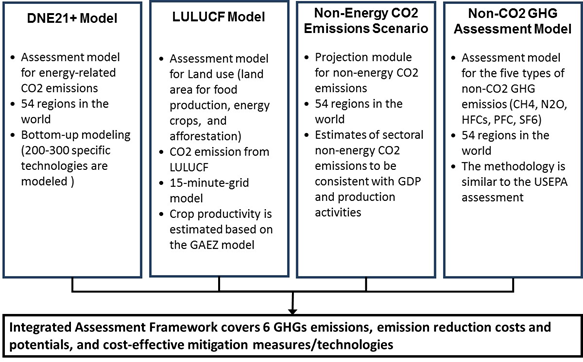Model concept, solver and details - DNE21+
| Corresponding documentation | |
|---|---|
| Previous versions | |
| Model information | |
| Model link | |
| Institution | Research Institute of Innovative Technology for the Earth (RITE), Japan, http://www.rite.or.jp/en/. |
| Solution concept | |
| Solution method | |
| Anticipation | |
RITE?s integrated assessment framework consists of 3 modules; 1) Key Assessment Model DNE21+ for energy-related CO2, 2) Non-energy CO2 emission scenario, which assumes specific non-energy CO2 emissions separately from mitigation levels of energy-related CO2 emissions 3) Non-CO2 GHG Assessment Model, for mitigation of the five non-CO2 greenhouse gases emissions of the Kyoto Protocol, based on the United States Environmental Protection Agency (US EPA) assessments.
Figure 1 Integrated Assessment Framework
DNE21+ is an intertemporal linear programming model for assessing global energy systems and global warming mitigation options. It represents energy systems (e.g., energy flows, capacities of energy related facilities) consistently in which the sum of the discounted total energy systems costs are minimized. The model represents regional differences and assesses detailed energy-related CO2 emission reduction technologies up to 2050. The energy supply sectors are hard-linked with energy end-use sectors, including energy exporting/importing; working lifetimes of facilities are taken into account so that assessments maintain complete consistency over energy systems and over time periods.
The base year of the model is 2000, and the GHG emissions are completely consistent with the historical data. The historical data on total GHG emissions for Annex I and non-Annex I parties are based on the GHG inventories of the UNFCCC and IEA statistics respectively. Energy-related CO2 emissions are based on the IEA statistics for all the countries. Whereas the statistical data for energy-related CO2 emissions differ between the UNFCCC and IEA in some countries, non-CO2 GHG emissions for Annex I parties are defined by subtracting the energy-related CO2 emissions reported by the IEA and the non-energy use CO2 emissions inventory of the UNFCCC from the total GHG emissions of the UNFCCC, thus, giving priority to the total GHG emission consistency with the UNFCCC inventory.
Technological costs and energy efficiency of technologies (various type of power generation technologies, oil refinery, coal gasification technology, etc.) and carbon dioxide capture, storage and sequestration are explicitly modeled. Energy intensive industries such as steel, cement, paper & pulp, aluminum, some groups of the chemical industry (ethylene, propylene production in the petrochemical industry and ammonia production), transportation (automobiles) and several groups of residential & commercial sector are also explicitly modeled ("Bottom-up approach?). The amounts of activities of these sectors (industry: outputs, automobiles: transportation demands, groups of residential & commercial sector: time periods of equipment utilization) are estimated exogenously and kept fixed in this model regardless of emissions constraints, while technological options are endogenously determined in the model. Other sectors, whose technological characteristics and future evolutions vary widely, are modeled in a top-down fashion.
